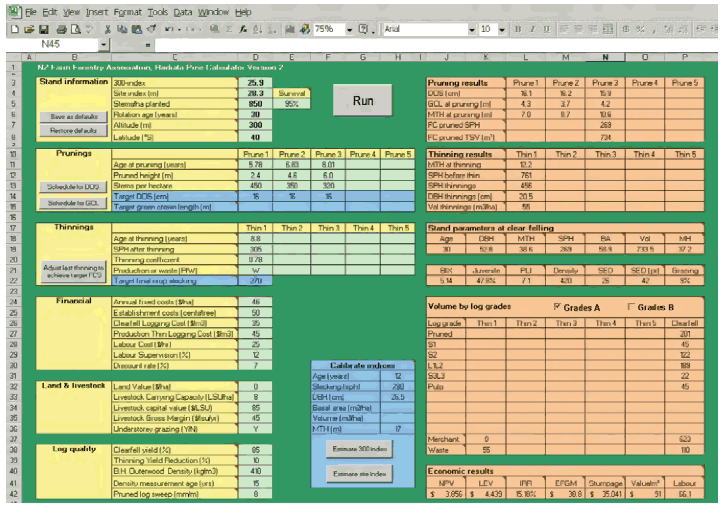Version 2 Calculators: Upgrading the business of farm forestry
Piers Maclaren & Leith Knowles, New Zealand Tree Grower May 2005.
Download the Radiata calculator version 4 (NZFFA members only) »
Is farm forestry a business or is it just a hobby? These days livestock farmers go to considerable trouble to obtain data on their pastures, livestock and soils. They use up-to-date research results and computer modelling to plan their farming operation. They know that the laid-back, ‘seems to work’ or ‘father did it this way’ approach will cost them money. In the long run it would ultimately cause the loss of their farms to someone who is more scientific and methodical.
So it is strange that, when it comes to farm forestry, many farm foresters revert to the old seat-of-the-pants approach. Perhaps it is because the results of second-rate forestry will not be noticed for many years, whereas sloppy farming will show up in this year’s returns? Anyway, there is no longer an excuse. Even with the poor forestry prices currently prevailing, a reasonable sized woodlot can be a major farm asset.
Calculators for radiata pine and Douglas fir are available to farm foresters and are cheap to license and simple to operate. These have been considerably upgraded from the Version 1 released two years ago.
The screen for the radiata pine Version 2 Calculator shown in this article is largely self-explanatory. But a comprehensive manual has recently been written to describe its use, and explain technical farm forestry terms to even a novice.
How the Version 2 Calculators can help
- What is the profitability of your proposed forestry investment?
- What quantity and quality of wood will you get at harvest?
- When is the best time to do your pruning and thinning?
- What is the most profitable silvicultural regime?
- What is the most profitable way around certain limitations, such as available labour or finance?
- What is the most profitable land use for a particular part of the farm? For example, is it best to retain certain paddocks in pasture or should they be converted to woodlots with a loss of grazing? Or is some combination of trees and understorey grazing the best option?
- What are the environmental consequences of a forestry scheme? For example, root biomass is a good guide of the extent to which trees will control erosion.
The advantages of the latest version
 The latest version have their own built-in growth models, log quality predictors, and log merchandising facilities. Compared to the first version they are a much more flexible tool, with greatly enhanced scope. They are designed to cover the full extent of radiata pine and Douglas fir in New Zealand, in terms of both geographical range and silvicultural options.
The latest version have their own built-in growth models, log quality predictors, and log merchandising facilities. Compared to the first version they are a much more flexible tool, with greatly enhanced scope. They are designed to cover the full extent of radiata pine and Douglas fir in New Zealand, in terms of both geographical range and silvicultural options.
All the inputs and outputs are found on one screen – you can easily and quickly see the effect of changing something. A special ‘Explorer’ facility can compare dozens of scenarios at once, and you can select the best one at a glance.
There are default values for all the things you do not know, or as an alternative to using defaults, the look-up tables located on tabs at the base of the screen help you estimate inputs.
The simple, user-friendly design means it is harder to make mistakes. Or if you do make mistakes, it is easier to notice them and correct them.
How do you make them work?
You can use the ‘Intro’ screen to get a rough answer quickly and easily, or if you are a more sophisticated user, you could choose the ‘User interface’ screen’ as shown below.
Both the physical and economic results are displayed. Pruning and thinning results tell you what you have done to the stand in these operations. Clearfelling results describing the state of the stand just prior to harvest, and also provide a detailed output of the volumes for each of the log grades that you have specified. Finally, there are seven economic results, each describing a different aspect of profitability.
Increasing returns
In recent years, there has been a steep increase in land prices, and an increasing awareness of the limitations of intensive pastoral farming in nutrient sensitive catchments or on erosion-prone hill country. These two factors mean that a hit or miss approach to land-use is no longer appropriate. For the modern farm-forester, an evening’s work with the Calculator has the potential to identify where trees fit on the farm, and to substantially increase returns.
If you are a member of the NZ Farm Forestry association, you can request a copy from Head Office.

 Farm Forestry New Zealand
Farm Forestry New Zealand